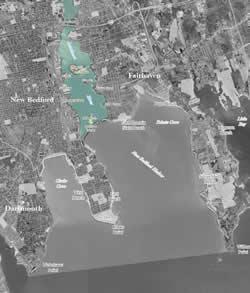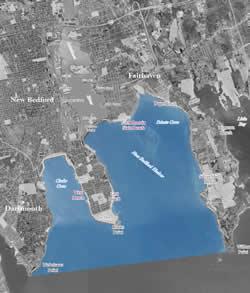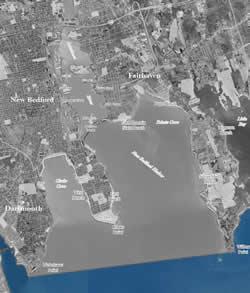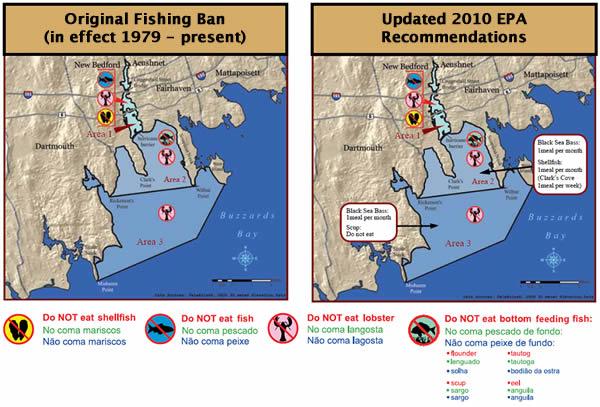Fish Consumption Regulations and Recommendations
Since 1979, Massachusetts regulations have prohibited eating fish and/or shellfish caught in certain areas of New Bedford Harbor. The Massachusetts Department of Environmental Protection samples local fish and shellfish every year to determine whether PCB concentrations are declining as a result of cleanup activities around New Bedford Harbor.
U.S. EPA recommends that recreational fishermen, shell fishermen and everyone else follow the Massachusetts regulations. In addition, we recommend limited eating of certain species not covered by the 1979 state regulations.
*Please see below for information on species specific information and recommendations for sensitive groups -- pregnant women, nursing mothers, children under age 12 and women who may become pregnant.
September 2015 Updated Seafood Recommendations
- Partnering with Mass Dept. of Environmental Protection
- Assessment with Mass Dept. of Public Health
- Recommendations
- Inner Harbor - Closure Area 1
- Outer Harbor - Closure Area 2
- Buzzards Bay - Closure Area 3
Partnering with Mass Dept. of Environmental Protection
As part of the NBH site monitoring, the Massachusetts Department of Environmental Protection has conducted annual fish and shellfish sampling to determine whether PCB concentrations in NBH fish and shellfish are declining as a result of cleanup activities. In general, PCB concentrations have indeed decreased from the 1980s to the present in most species, although concerns remain as discussed herein. Fish and shellfish sampling will continue throughout the cleanup efforts, and updates to this fact sheet will be issued as appropriate.
Assessment with Mass Dept. of Public Health
The Massachusetts Department of Public Health (MDPH) has also had extensive involvement with NBH in order to address a variety of health concerns. In 1979, MDPH promulgated state regulations prohibiting the consumption of any fish/shellfish in Area 1 of NBH; of bottom feeding fish (eel, scup, flounder, and tautog) or lobster in Area 2; and lobster in Area 3 (see attached map). These early efforts were followed by human epidemiological studies of PCB exposure via fish consumption by MDPH and others. *MDPH has additional advice for sensitive populations (pregnant women, nursing mothers, children under age 12, women who may become pregnant) that can be found at www.mass.gov/eohhs/gov/departments/dph/programs/environmental-health/exposure-topics/fish-wildlife/fish/ Exit. EPA supports this additional advice, and notes that its updated risk assessment (discussed below) recommends that sensitive populations avoid fish, shellfish and lobster from the three closure areas in NBH (see map on reverse) except that shellfish from Area 3 and Clark's cove may safely be consumed by these sensitive populations if limited to one meal per month.
Recommendations
As part of the Superfund process, EPA is required to conduct risk assessments that will result in cleanup levels that the selected remedy for a given site must meet. These risk assessments use conservative (health-protective) assumptions to ensure that even sensitive populations will not have health concerns following completion of remediation activities. In the case of NBH and the risk assessment conducted on fish/shellfish in the closed areas of the harbor, EPA's updated evaluation indicates that some species not currently covered by the 1979 state regulations may present health concerns for recreational fishermen and shell fishermen (and/or their families/friends who consume their take) if these species are consumed in larger quantities than current epidemiological data suggest. EPA believes it is important that recreational fishermen and shell-fishermen be aware that the risk assessment suggests that: consumption of black sea bass be limited to one meal per month if they are obtained in Areas 2 and 3; that scup not be consumed from Areas 2 or 3; and that general guidelines for shellfish include limiting consumption to one meal a month in Area 2 (one meal per week in Clark's Cove). See map above for a summary of EPA's recommendations.
It is important to recognize the substantial benefits of fish consumption for everyone. Fish is one of the best sources of fatty acids which are helpful in reducing the risk of heart disease. In order to avoid exposure to a harmful level of contaminants, people should choose a variety of fish and shellfish from a variety of sources.
The tables on this page show Massachusetts regulations and U.S. EPA recommendations for eating fish, shellfish and lobster caught in three fish closure areas around New Bedford Harbor. In two of the three closure areas, we have different advice for sensitive populations -- pregnant women, nursing mothers, children under age 12, and women who may become pregnant -- than for the general population. This special advice is noted at the bottom of the tables for Areas 2 and 3. Safe seafood is an important part of a healthy diet. People should choose a variety of fish and shellfish from a variety of sources.

Closure Area 1Inner Harbor:North of the hurricane barrier and Ft. Phoenix Beach State Reservation -- Includes Palmer Island -- Map of the upper and lower harbors (PDF) (1 pg, 622 K, about PDF) Map of the three fish closure areas in the NBH area |
|
|---|---|
|
If you catch…
|
then…
|
|
Any shellfish, lobster, or fish, including bottom feeders
|
Do not eat it
|

Closure Area 2Outer Harbor:South of the hurricane barrier to Ricketsons Point and tip of Sconticut Neck (Wilbur Point) -- Includes Clarks Cove -- Map of the upper and lower harbors (PDF) (1 pg, 622 K, about PDF) Map of the three fish closure areas in the NBH area |
|
|---|---|
|
If you catch…
|
then…
|
| Fish: | |
|
Black sea bass
|
Eat no more than one meal per month
|
|
All bottom-feeding fish including:
|
|
|
Eel
|
Do not eat it |
|
Flounder
|
Do not eat it |
|
Scup
|
Do not eat it |
|
Tautog
|
Do not eat it |
|
All other fish
|
U.S. EPA does not have adequate data so cannot make a recommendation
|
|
Lobster
|
Do not eat it
|
|
Shellfish (clams, quahogs, mussels etc.)
|
Eat no more than one meal per month.
Exception -- Shellfish caught in Clarks Cove: eat no more than one meal per week |
| NOTE: Pregnant women, nursing mothers, children under age 12, and women who may become pregnant should not eat fish, shellfish or lobster caught in Closure Area 2, except they can safely eat one, and only one, meal per month of shellfish caught in Clarks Cove. | |

Closure Area 3Buzzards Bay:South of Ricketsons Point and the tip of Sconticut Neck (Wilbur Point) To Mishaum Point in Dartmouth and West Island South Point in Fairhaven -- Includes area south of the West Island Causeway -- Map of the three fish closure areas in the NBH area |
|
|---|---|
|
If you catch…
|
then…
|
|
Fish:
|
|
|
Black sea bass
|
Eat no more than one meal per month
|
|
Bottom-feeding fish:
|
|
|
Eel
|
U.S. EPA does not have adequate data so cannot make a recommendation
|
|
Flounder
|
U.S. EPA does not have adequate data so cannot make a recommendation
|
|
Scup
|
Do not eat it
|
|
Tautog
|
Eat no more than one meal per month
|
|
All other fish, including
all other bottom-feeders |
U.S. EPA has no data yet so cannot make a recommendation
|
|
Lobster
|
Do not eat it
|
|
Shellfish (clams, quahogs, mussels etc.)
|
There are no eating restrictions
|
| NOTE: Pregnant women, nursing mothers, children under age 12, and women who may become pregnant should not eat fish or lobster caught in Closure Area 3. They can safely eat one, and only one, meal per month of shellfish caught in Area 3. | |

